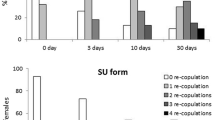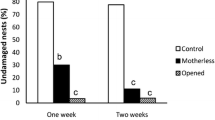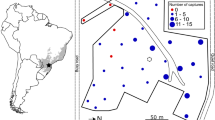Summary
Philoponella oweni (Uloboridae) is a facultatively communal orb-web spider found in arid regions in the southwestern United States. Within one habitat solitary adult females and communal groups of adult females coexist.
This study compared the reproductive output (egg production) and reproductive success (production of live offspring) of solitary and communal females. There was no significant difference in the mean number of egg-cases produced by solitary and communal females, but communal females produced significantly more eggs per egg-case. However, communal females suffered significantly higher rates of egg-case parasitism from the pteromalid wasp Arachnopteromalus dasys. As a result, the mean number of liver offspring produced by solitary and communal females did not differ. Thus, both strategies led to roughly equal reproductive success. The advantages of aggregation of adults may be significant in the evolution of social behavior in spiders.
Similar content being viewed by others
References
Bradoo B (1973) The cocoon spinning behaviour and fecundity of Stegodyphus sarasinorum Karsch (Araneae: Eresidae) from India. J Bombay Nat Hist Soc 72:392–398
Buskirk R (1981) Sociality in the Arachnida. In: Hermann H (ed) Social insects, vol II, chap 7. Academic Press, New York, pp 281–367
Butler L (1933) The common and conspicuous spiders of Melbourne. Victorian Nat 49:27–292
Darchen, R (1967) Une nouvelle araignée sociale du Gabon, Agelena republicana Darchen (Aranéidae labidognathe). Biol Gabon 3:31–42
Darchen R (1968) Ethologie d'Achaearanea disparata Denis, Araneae, Theridiidae, araignée sociale du Gabon. Biol Gabon 4:5–25
Eberhard W (1979) Rates of egg production by tropical spiders in the field. Biotropica 11:292–300
Evans H (1958) The evolution of social life in wasps. Proc Xth Int Congr Entomology, Montreal (1956) 2:449–457
Fowler H Diehl J (1978) Biology of a Paraguayan colonial orb-weaver, Eriophora bistriata (Rengger) (Araneae, Araneidae). Bull Br Arachnol Soc 4:241–250
Gordh G (1976) A new genus of Pteromalidae from Missouri, the type species of which parasitizes Uloborus octonarius Muma (Hymenoptera: Chalcidoidea; Araneida: Uloboridae). J Kans Entomol Soc 49:100–104
Jacson C, Joseph K (1973) Life history, bionomics and behavior of the social spider Stegodyphus sarasinorum Karsch. Insectes Soc 20:189–203
Kaston B (1948) Spiders of Connecticut. State geological and natural history survey. Peiper Press, Wallingford, Connecticut
Krafft B (1970) Contribution à la biologie et à l'ethologie d'Agelena consociata Denis (Araignée sociale du Gabon) Première Partie. Biol Gabon 6:199–301
Kullmann E (1972) Evolution of social behavior in spiders (Araneae; Eresidae and Theridiidae). Am Zool 12:419–426
Kullmann E, Zimmerman W (1974) Regurgitationsfütterungen als Bestandteil der Brutfürsorge bei Haubennetz- und Röhrenspinnen (Araneae, Theridiidae und Eresidae). Proc VIth Int Arachnol Congr, Amsterdam
Lahmann E, Eberhard W (1979) Factores selectivos que afectan la tendencia a agruparse en la araña colonial Philoponella semiplumosa (Araneae; Uloboridae). Rev Biol Trop 27:231–240
Lin N, Michener C (1972) Evolution of sociality in insects. Q Rev Biol 47:131–159
Lubin Y (1974) Adaptive advantages and the evolution of colony formation in Cyrtophora (Araneae: Araneidae). Zool J Linn Soc 54:321–339
Lubin Y (1980) Population studies of two colonial orb-weaving spiders. Zool J Linn Soc 70:265–287
Michener C (1958) The evolution of social behavior in bees. Proc Xth Int Congr Entomology, Montreal (1956) 2:441–447
Millot J, Bourgin P (1942) Sur la biologie des Stegodyphus solitaires (Araneides Eresides). Bull Biol Fr Belg 76:299–314
Muma M, Gertsch W (1964) The spider family Uloboridae in North America north of Mexico. Am Mus Novit 2196:1–43
Opell B (1979) Revision of the genera and tropical American species of the spider family Uloboridae. Bull Mus Comp Zool 148:443–547
Peterson B (1950) The relation between size of the mother and number of eggs and young in some spiders and its significance for the evolution of size. Experientia 6:96–98
Rypstra A (1979) Foraging flocks of spiders. A study of aggregate behavior in Cyrtophora citricola Forskal (Araneae; Araneidae) in West Africa. Behav Ecol Sociobiol 5:291–300
Sabath M, Sabath L, Moore A (1974) Web, reproduction and commensals of the semisocial spider Cyrtophora moluccensis (Araneae: Araneidae) on Guam, Mariana Islands. Micronesica 10:51–55
Simon W (1891) Observations biologiques sur les Arachnides. Ann Soc Entomol Fr 60:5–14
Stern H, Kullman E (1975) Leben am seidenen Faden. Die rätselvolle Welt der Spinnen. Bertelsmann, Munich
Struhsaker T (1969) Notes on the spiders Uloborus mundior (Chamberlin and Ivie) and Nephila clavipes (Linnaeus) in Panama. Am Mild Nat 82:611–613
West Eberhard M (1975) The evolution of social behavior by kin selection. Q Rev Biol 50:1–33
West Eberhard M (1978) Polygyny and the evolution of social behavior in wasps. J Kans Entomol Soc 51:832–856
Wise D (1975) Food limitation of the spider Linyphia marginata: experimental field studies. Ecology 56:637–646
Author information
Authors and Affiliations
Rights and permissions
About this article
Cite this article
Smith, D.R. Reproductive success of solitary and communal Philoponella oweni (Araneae: Uloboridae). Behav Ecol Sociobiol 11, 149–154 (1982). https://doi.org/10.1007/BF00300057
Received:
Accepted:
Issue Date:
DOI: https://doi.org/10.1007/BF00300057




